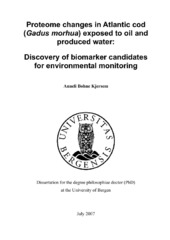Proteome changes in Atlantic cod (Gadus morhua) exposed to oil and produced water: discovery of biomarker candidates for environmental monitoring
Doctoral thesis
Permanent lenke
https://hdl.handle.net/1956/2635Utgivelsesdato
2007-09-07Metadata
Vis full innførselSamlinger
Sammendrag
Produced water is the most dominating source of continuous oil discharges to the sea offshore. It contains a wide range of compounds such as alkyl phenols, polyaromatic hydrocarbons (PAHs), heavy metals, carboxylic acids and other organic compounds, which may cause harm by themselves or in synergy with other compounds present in produced water. Worldwide there is a growing concern that contamination of the marine environment may constitute an important contribution to the reported decline in harvested populations of marine fish species, and early life stages have been reported to be more sensitive to xenobiotic exposure than adult fish. Proteomics were applied to identify changes in the proteome of Atlantic cod (Gadus morhua) exposed to crude North Sea oil and North Sea produced water at different life stages and during early development. Apparent protein changes were identified and linked to possible signalling pathways and mechanisms involved in the biological response of fish following exposure. Exposure to North Sea crude oil and produced water appeared to induce a large number of changes, also at low levels of exposure. More than 40 of the 137 protein changes detected in plasma of juvenile cod following exposed to crude oil and surrogate produced water appeared at the lowest level of exposure, 0.06 ppm crude oil. Almost all of the protein changes detected in whole fry and fry liver following produced water exposure occurred at the lowest levels of produced water, 0.01% and 0.1% produced water. In total 137 proteins appeared to change in plasma of juvenile cod exposed to crude oil and oil spiked with PAHs and alkyl phenols. 84 proteins appeared to change in whole cod fry exposed to produced and oestradiol from egg to fry stage whereas 105 proteins appeared to change in liver of cod fry exposed to produced and oestradiol. Comparing the results from produced water exposure with oestradiol exposure, suggest that some of the responses may be related to endocrine disrupting effects. However, about 25% - 50% of the produced water affected proteins did not change following oestradiol exposure. The biomarker candidates found in this study includes a vide range of different protein previously been reported to be involved in a variety cellular and molecular functions, indicating effects on the immune system, the fibrinolytical system, iron hemostasis, fertility, metabolism, perception, morphology and development. The levels of exposure used in this study are supposed to reflect both acute discharges and long-term, chronic exposures, levels of exposure close to back-ground levels and distances far from the platforms, as well as higher levels of exposure comparable to the expected concentrations in close proximity of the oil installations offshore. The biomarker candidates discovered in this study will have to be verified and validated for use as biomarkers in environmental monitoring in future studies. The PhD project “Proteome changes in Atlantic cod (Gadus morhua) exposed to oil and produced water: Discovery of biomarker candidates for environmental monitoring” is funded by Total E&P Norway and was carried out at the Department of Molecular Biology, The University of Bergen, Norway.
